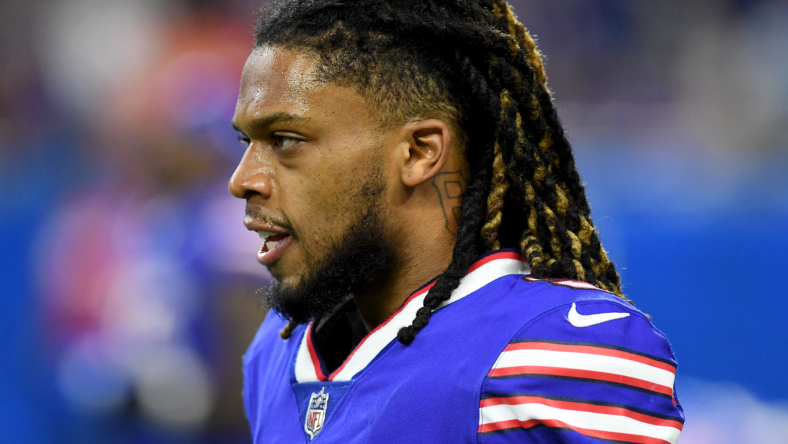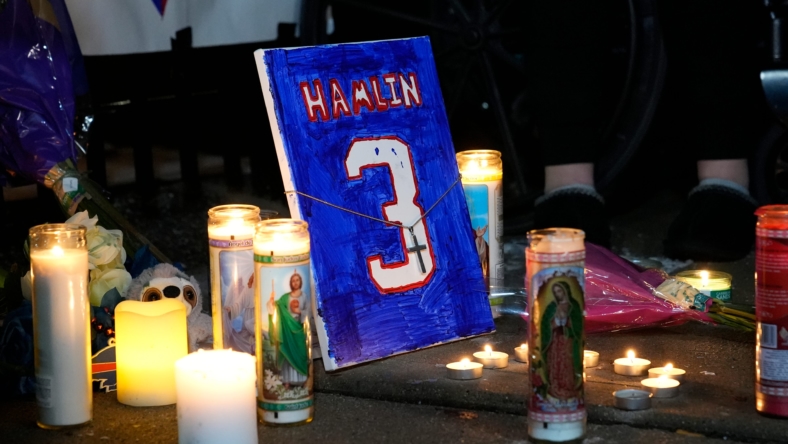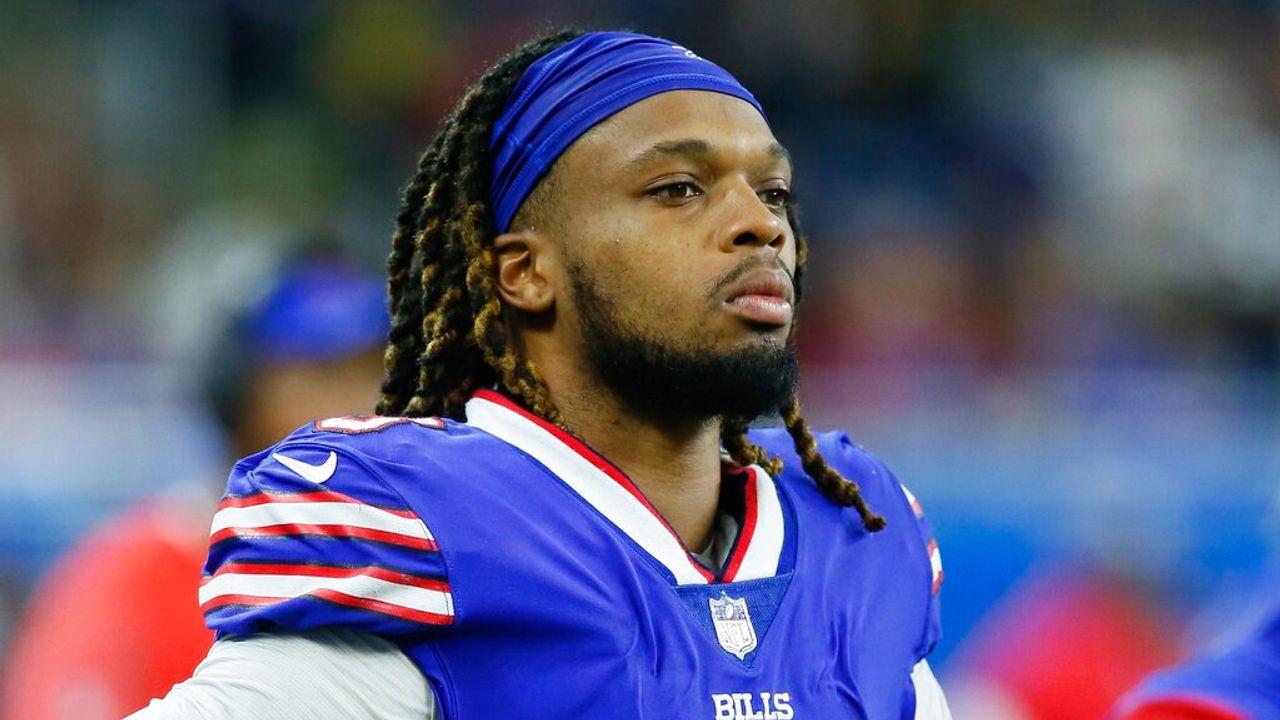Update on Damar Hamlin reveals Buffalo Bills player is awake, communicating
Andrew Buller-Russ
 Lon Horwedel-USA TODAY Sports
Lon Horwedel-USA TODAY SportsThe only story around the NFL right now is all about the health and safety of 24-year-old Buffalo Bills safety Damar Hamlin. Vibes around the league just haven’t been the same since Monday night, when millions witnessed Hamlin’s injury occur, which required CPR, and resulted in his hospital stay in Cincinnati ever since.
Yet, we’ve continued to receive trickles of information regarding the Pennsylvania native’s condition, and on Thursday, more updates were released.
Here’s the latest we know.
Damar Hamlin still on a breathing tube, but is communicating via writing
 Cara Owsley/The Enquirer / USA TODAY NETWORK
Cara Owsley/The Enquirer / USA TODAY NETWORKAccording to doctors who have been apprised of the situation, Hamlin is now awake but is also hooked up to a breathing tube to ensure he receives enough oxygen. He’s also been able to communicate only in written form.
The doctors at the University of Cincinnati Medical Center suggest there is even still hope for Hamlin to pick up where he left off with a normal life before the incident occurred.
On Thursday, the Bills made an official statement regarding the improving health of Hamlin.
“Per the physicians caring for Damar Hamlin at the University of Cincinnati Medical Center, Damar has shown remarkable improvement over the past 24 hours. While still critically ill, he has demonstrated that he appears to be neurologically intact. His lungs continue to heal and he is making steady progress.”Buffalo Bills official statement on Damar Hamlin’s health
With Hamlin’s health improving, one of the top topics on his mind was to learn who won the Week 17 matchup between the Bills and Cincinnati Bengals. He proceeded to ask about the outcome of the game to those around him in the hospital room, to which they had a great response.
Of course, the game stopped after roughly nine minutes of play in the first quarter after Hamlin’s serious injury occurred and has since been suspended. The most recent indication is that the Bills-Bengals matchup will not be resumed at all and will be canceled in short order.
Yet, it’s safe to say nobody really cares about whether a game is played or not. It’s all about Hamlin at this point. We all just want to see him safe and sound, even his opponents.
Buffalo Bills football player Damar Hamlin in critical condition after heart stops mid-game
 Buffalo Bills safety Damar Hamlin (3) during the second half of an NFL football game against the Cleveland Browns, Sunday, Nov. 20, 2022, in Detroit. [AP Photo/Duane Burleson]
Buffalo Bills safety Damar Hamlin (3) during the second half of an NFL football game against the Cleveland Browns, Sunday, Nov. 20, 2022, in Detroit. [AP Photo/Duane Burleson]
During Monday night’s nationally televised National Football League (NFL) game between the Cincinnati Bengals and the Buffalo Bills, Damar Hamlin, the safety for the Bills, collapsed after his heart stopped during the first quarter.
Hamlin had just made a tackle on a Bengals player and received a hard blow to his chest. He stood up immediately following the play, but collapsed seconds later. Medical staff responded quickly and administered CPR, which apparently succeeded in restarting his heart.
Hamlin was removed from the field by stretcher and rushed to the University of Cincinnati Medical Center, where he remains in the Intensive Care Unit in critical condition. Reports Tuesday night from family members at the hospital depicted a grim situation for the 24-year-old athlete.
An uncle, Dorrian Glenn, who visited Hamlin at the hospital told the press that Damar has required resuscitation at least twice and has been in a state of sedation. Glenn added that for now Hamlin had to remain on his stomach so as to drain blood from his lungs, and that he was able to breathe only with the assistance of a ventilator.
While a full and detailed medical report on Hamlin has yet to be given to the public, the fact that he suffered a severe heart episode should be of great concern for all young athletes. For one thing, it has been medically established that COVID-19 infections can lead to a higher risk of myocarditis, an inflammation of the heart, especially among young men.
Since the outbreak of the pandemic, the condition has become increasingly common in college athletes. In at least one case, a 20-year-old college football player, Jamain Stephens, died from myocarditis, which had developed after he had been infected with COVID-19.
In a formal statement, Hamlin’s family wrote: “On behalf of our family, we want to express our sincere gratitude for the love and support shown to Damar during this challenging time. We are deeply moved by the prayers, kind words, and donations from fans around the country.”
The statement extended special thanks to the medical staff and first responders who are caring for Hamlin.
After Hamlin collapsed on the field, his teammates and opponents alike could be seen struggling to hold back tears, fearing that they had just witnessed a fellow athlete die. Only minutes afterward, top officials in the NFL informed the teams that they had five minutes to “warm up” and continue the game.
The players responded by refusing to continue the game, instead gathering on the field and kneeling together in a moment of prayer. Shortly afterwards, the NFL officially suspended the game and ended the live TV broadcast.
In a desperate attempt to save face, the NFL is now denying that it ever told players they had to continue playing. However, at least one ESPN reporter, Joe Buck, is insisting he was told by an NFL official that players were expected to be back on the field within five minutes of Hamlin being carried off on a stretcher.
An estimated 14 million people watched Hamlin collapse. Once it became clear that the players had no intention of resuming the game while Hamlin’s survival was in question, the League conceded. It feared the repercussions of what could have turned into an angry protest by the players, broadcast into millions of homes, against any attempt to force them to resume play.
On Tuesday, the NFL issued a statement saying that the Bills-Bengals game would not be resumed this week and that no decision had been made as to whether it would be rescheduled for a later date. The statement went on to say, however, that the games scheduled for next week would go ahead as planned, and that the Bills would be expected to play the New England Patriots on Sunday.
There will be immense pressure from the billionaire team owners to reschedule the Bengals-Bills game. They will seek to minimize lost revenue from the halting of Monday’s game. Moreover, failure to replay the game could impact the placement of the Bills in the extremely lucrative post-season playoffs.
On average, an NFL team takes in over $10 million per game just from ticket sales. On top of that, owners take home massive profits from TV broadcasting rights and advertising. In 2021, across all teams, the NFL generated a combined $17 billion.
In the immediate aftermath of Monday’s tragedy, there has been an outpouring of support for the young athlete and his family. There have been thousands of heartfelt posts on social media. Many have expressed outrage at the NFL for even considering making the players continue the game. Others have expressed horror that such a deadly incident could occur in professional football, the most popular sport in the US.
The National Football League Players Association (NFLPA), the official union of the players, said in a brief statement on Tuesday: “Our focus remains on the health of our brother, Damar Hamlin. We continue to be in touch with the clubs and the NFL to ensure that Bills and Bengals players have every resource available to aid and support them during this time.”
It is unlikely that the NFLPA will take any action against the NFL. Historically, the role of the NFLPA, which is part of the AFL-CIO, has been to help the NFL save face and keep protests from players hidden from public view. It has never made any attempt to hold team owners or NFL officials responsible for the physical and mental injuries sustained by players.
Hamlin’s near-fatal experience is the second high-profile injury this year in the NFL. The first was the seizure suffered by Miami Dolphins quarterback Tua Tagovailoa in late September, which occurred after he was allowed to return to action despite having suffered a concussion.
The incident was a display of blatant negligence. Independent medical experts who observed Tagovailoa’s injury have gone on record saying that he has already likely sustained irreversible brain trauma.
Since then, Tagovailoa was again cleared to return to the field by the NFL. But in a Christmas Day game against the Green Bay Packers, he suffered yet another head trauma. In this most recent instance, he was not removed from play, despite signs that the injury had a clear impact on his performance. It was not until the next day that Tagovailoa self-reported to the team’s medical staff that he had again been placed in the concussion protocol.
Understanding cardiac arrest and emergency response following Damar Hamlin’s collapse during Monday Night Football
On-site care explanations, Possible causes, Traumatic Stress of responders/observers, Resources for learning CPR
Reports and ProceedingsDALLAS, January 3, 2023 — While playing in the Buffalo Bills - Cincinnati Bengals game on Monday Night Football on January 2, Bills player Damar Hamlin suffered cardiac arrest after a hit and was administered CPR on the field before being transferred to an area hospital, according to an overnight statement by the Buffalo Bills.
On-site care explanation
Hamlin reportedly experienced a cardiac arrest – when the heart stops abruptly with little or no warning. Early recognition of cardiac arrest improves the person’s chance of survival and is key to starting the correct care of CPR and the appropriate use of defibrillation to restart the heart. The on-site medical team evaluated the situation and appeared to quickly remove his safety pads, begin CPR and apply the automated external defibrillator (AED).
CPR can help keep the heart pumping and blood flowing to vital organs until an electrical shock from a defibrillator is available to restore the heart to a normal heart rhythm. Then the patient can be safely moved for further medical treatment, supportive care, testing to determine what the cause of the arrest may have been and recovery, including both physical and mental health resources for the person and their family.
Possible causes
Cardiac arrest can have several causes. Since Hamlin collapsed immediately following a tackle on the play, one potential cause could be commotio cordis. Commotio cordis is a rare phenomenon from a sudden blunt impact to the chest causing sudden death in the absence of apparent cardiac damage.[1] The blow to the chest at precisely the wrong time in the cardiac cycle causes an electrical abnormality in the heart resulting in an irregular heart rhythm that cannot pump blood to the body. Immediate CPR and a shock to reset the rhythm can help the heartbeat return to normal function.
Another cause of cardiac arrest that additional tests are likely to attempt to detect or rule out is hypertrophic cardiomyopathy (HCM) or a thickened heart muscle – a more common cause of sudden cardiac death in young people and athletes specifically. The thickened heart can be due to a genetic condition or can be caused by athletic conditioning that thickens the muscles of the heart and can make it more susceptible to an irregular heart rhythm like ventricular fibrillation/tachycardia[2].
Traumatic stress for responders, observers
Witnessing and responding to a cardiac arrest can be a very traumatic event and may cause lingering psychological impact regardless of the outcome. Lay responders and witnesses may need support and resources to help process their experience.
Responders have cited exhaustion, guilt, flashbacks, sleep disturbances, self-doubt, anger, sadness and fear. A positive outcome to performing CPR can mitigate some of the emotional responses; however, psychological responses are wide-ranging and individualized. In situations with a failed resuscitation attempt, PTSD symptom scores were twice as high for responders as those for non-witnesses.
“This was traumatic for everyone, especially Hamlin’s family and teammates but also for so many others involved and witnessing the event. More than 70% of cardiac arrests that do not happen in the hospital, occur in a home where access to medical professionals and an AED is not as readily available,” said Mariell Jessup, M.D., FAHA, chief science and medical officer of the American Heart Association. “Recognizing a cardiac arrest, calling 911 immediately, performing CPR and using an AED as soon as it is available are critical for survival. Statistically speaking, it is likely that the person will need to be helped by a family member or a friend in order to survive.”
Having community members trained in CPR and AEDs in public spaces can increase the chances of survival. The rate of bystander CPR in North America is estimated at only 39-44%, and only about 1 in 10 people survive an out-of-hospital cardiac arrest. Improving the rate of bystander CPR is critical to increasing survival from out-of-hospital cardiac arrest (OHCA).
The skill to perform CPR and use a defibrillator are the foundational components of preparing laypeople to respond to cardiac arrest. People also need to feel emotionally prepared to respond and be able to cope with the aftermath of actually performing CPR.[3]
Resources for learning CPR
Each year in the United States, an estimated 350,000 people experience sudden cardiac arrest in the community[4]. Anyone who witnesses a cardiac arrest in the community (i.e., not in a hospital) can perform CPR. Roughly 70% of cardiac arrests that do not happen in the hospital, occur in homes and private residences, therefore, a friend or family member is mostly likely to be the person who needs to take action. CPR, especially if performed immediately, can double or triple a cardiac arrest victim’s chance of survival.
For adults and adolescent children, Hands-Only CPR is an easy-to-learn skill that requires only two steps: call emergency services and push hard and fast in the center of the chest at a rate of 100-120 beats per minute.
Additional Resources:
- Multimedia may be downloaded from the right column of the release link https://newsroom.heart.org/news/understanding-cardiac-arrest-and-emergency-response-following-damar-hamlins-collapse-during-monday-night-football?preview=4c22c366f7a02d3539446db455606e1b
- Understanding the Importance of the Lay Responder Experience in Out-of-Hospital Cardiac Arrest: A Scientific Statement From the American Heart Association
- Difference in Cardiac Arrest vs. Heart Attack
- Learn Hands-Only CPR/use and AED (English and Spanish)
- AHA health information: Bystander CPR
- AHA health information: Bystander CPR Infographic
- AHA health information: Hands-Only CPR Resources
- Follow AHA/ASA news on Twitter @HeartNews
About the American Heart Association
The American Heart Association is a relentless force for a world of longer, healthier lives. We are dedicated to ensuring equitable health in all communities. Through collaboration with numerous organizations, and powered by millions of volunteers, we fund innovative research, advocate for the public’s health and share lifesaving resources. The Dallas-based organization has been a leading source of health information for nearly a century. Connect with us on heart.org, Facebook, Twitter or by calling 1-800-AHA-USA1.
###
For Media Inquiries and AHA Expert Perspective:
Karen Springs, 214-706-4831, karen.springs@heart.org
For Public Inquiries: 1-800-AHA-USA1 (242-8721)
heart.org and stroke.org
[1] Circulation: Arrhythmia and Electrophysiology. 2012;5:425–4321 Apr 2012. https://doi.org/10.1161/CIRCEP.111.962712
[2] Sudden deaths in young competitive athletes: analysis of 1866 deaths in the United States, 1980-2006.Circulation. 2009; 119:1085–1092. doi: 10.1161/CIRCULATIONAHA.108.804617
[3] Understanding the Importance of the Lay Responder Experience in Out-of-Hospital Cardiac Arrest: A Scientific Statement From the American Heart Association, https://www.ahajournals.org/doi/10.1161/CIR.0000000000001054
[4] Heart disease and stroke statistics-2022 update: a report from the American Heart Association. Circulation. doi: 10.1161/CIR.0000000000001052
No comments:
Post a Comment